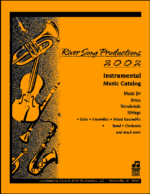-
Amazing Grace
$4.00After a brief introduction this French horn solo present the tune “as is” while the piano uses two-part imitation lines underneath. The piece progresses with the horn line modifying the tune rhythmically. After a modulation the piano presents the melody in an altered form while the solo has a gentle obligatto. The final section is more punctuated moving to a solemn section of repose.
-
-
Amazing Grace
$5.95Moving and affective this solo begins unaccompanied and then later joined by the piano in a Celtic style. A second statement of the tune is further embellished and gains more complexity as it progresses. After a brief modulation the solo line becomes more plaintive- even though still embellished. The Coda is based on a brief motif where it ritards into a gentle repose.
-
Amazing Grace
$5.95Moving and affective this solo begins unaccompanied and then later joined by the piano in a Celtic style. A second statement of the tune is further embellished and gains more complexity as it progresses. After a brief modulation the solo line becomes more plaintive- even though still embellished. The Coda is based on a brief motif where it ritards into a gentle repose.
-
Amazing Grace
$5.95Moving and affective this solo begins unaccompanied and then later joined by the piano in a Celtic style. A second statement of the tune is further embellished and gains more complexity as it progresses. After a brief modulation the solo line becomes more plaintive- even though still embellished. The Coda is based on a brief motif where it ritards into a gentle repose.Unusual, emotive and restrained version of the Luther classic The introduction in the piano is presented in an embellished fashion. The solo states the theme in a straight-forward manner. After a brief interlude the solo continues in a different register. Another brief interlude and the soloist continue in a more ornamented manner this time. The piano now states the theme in strong block chords while the solo is very active as an obbligato. Both voices present thematic materials taken from the opening sections. The Coda gives a motivic statement of the opening theme and resolves to a solemn end.
-
Amazing Grace
$5.95Moving and affective this solo begins unaccompanied and then later joined by the piano in a Celtic style. A second statement of the tune is further embellished and gains more complexity as it progresses. After a brief modulation the solo line becomes more plaintive- even though still embellished. The Coda is based on a brief motif where it ritards into a gentle repose.
-
Amazing Grace
$5.95Moving and affective this solo begins unaccompanied and then later joined by the piano in a Celtic style. A second statement of the tune is further embellished and gains more complexity as it progresses. After a brief modulation the solo line becomes more plaintive- even though still embellished. The Coda is based on a brief motif where it ritards into a gentle repose.
-
Amazing Grace
$5.95Moving and affective this solo begins unaccompanied and then later joined by the piano in a Celtic style. A second statement of the tune is further embellished and gains more complexity as it progresses. After a brief modulation the solo line becomes more plaintive- even though still embellished. The Coda is based on a brief motif where it ritards into a gentle repose.
-
Amazing Grace
$5.95Moving and affective this solo begins unaccompanied and then later joined by the piano in a Celtic style. A second statement of the tune is further embellished and gains more complexity as it progresses. After a brief modulation the solo line becomes more plaintive- even though still embellished. The Coda is based on a brief motif where it ritards into a gentle repose.
-
Amazing Grace
$5.95Moving and affective this solo begins unaccompanied and then later joined by the piano in a Celtic style. A second statement of the tune is further embellished and gains more complexity as it progresses. After a brief modulation the solo line becomes more plaintive- even though still embellished. The Coda is based on a brief motif where it ritards into a gentle repose.
-
-
-
Glorious Things Of Thee Are Spoken
$14.95Haydn’s original variations from his Quartet, Op. 76, No. 3 arranged for quintet
-
Amazing Grace
$5.00This solo opens with a gentle, Celtic fashion in a duple meter. It progresses through a series expressive obbligati giving a sense of elevation. As it nears the end it modulates metrically and harmonically to a triple meter, and then final repose.
-
Amazing Grace
$30.00Beginning with a horn rubato soli, features a modal open solo section in the middle before returning to the rubato Gospel Blues which features the piano. … Sx, 3 Tbn, Pno, Bass, Gtr, Organ)
-
Glorious Things Of Thee Are Spoken
$7.95Light and delicate textures that are enriched with poignant harmonies aptly complement this timeless Austrian Hymn.
Flute Duet with Piano Accompaniment -
Glorious Things Of Thee Are Spoken
$7.95Light and delicate textures that are enriched with poignant harmonies aptly complement this timeless Austrian Hymn.
Flute Duet with Piano Accompaniment -
-
-
-
-
-
-
Amazing Grace
$20.00(in manuscript at this time)(Music to accompany congregational singing. Scored for full orchestra but are playable by smaller groups. May also be performed by instruments alone. Parts included for kybd and/or rhythm) 4 verses in F,F,G, & Ab











